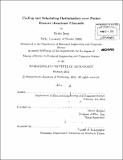| dc.contributor.advisor | Muriel Médard. | en_US |
| dc.contributor.author | Zeng, Weifei | en_US |
| dc.contributor.other | Massachusetts Institute of Technology. Dept. of Electrical Engineering and Computer Science. | en_US |
| dc.date.accessioned | 2012-07-02T15:48:22Z | |
| dc.date.available | 2012-07-02T15:48:22Z | |
| dc.date.copyright | 2012 | en_US |
| dc.date.issued | 2012 | en_US |
| dc.identifier.uri | http://hdl.handle.net/1721.1/71501 | |
| dc.description | Thesis (S.M.)--Massachusetts Institute of Technology, Dept. of Electrical Engineering and Computer Science, 2012. | en_US |
| dc.description | Cataloged from PDF version of thesis. | en_US |
| dc.description | Includes bibliographical references (p. 93-97). | en_US |
| dc.description.abstract | Throughput and per-packet delay can present strong trade-offs that are important in the cases of delay sensitive applications. In this thesis, we investigate such trade-offs using a random linear network coding scheme for one or more receivers in single hop wireless packet erasure broadcast channels. We capture the delay sensitivities across different types of network applications using a class of delay metrics based on the norms of packet arrival times. With these delay metrics, we establish a unified framework to characterize the rate and delay requirements of applications and optimize system parameters. In the single receiver case, we demonstrate the trade-off between average packet delay, which we view as the inverse of throughput, and maximum ordered inter-arrival delay for various system parameters. For a single broadcast channel with multiple receivers having different delay constraints and feedback delays, we jointly optimize the coding parameters and time-division scheduling parameters at the transmitters. We formulate the optimization problem as a Generalized Geometric Program (GGP). This approach allows the transmitters to adjust adaptively the coding and scheduling parameters for efficient allocation of network resources under varying delay constraints. In the case where the receivers are served by multiple non-interfering wireless broadcast channels, the same optimization problem is formulated as a Signomial Program, which is NP-hard in general. We provide approximation methods using successive formulation of geometric programs and show the convergence of approximations. Practical issues of implementing proposed coding and optimization scheme on existing layered network architecture are also discussed. | en_US |
| dc.description.statementofresponsibility | by Weifei Zeng. | en_US |
| dc.format.extent | 97 p. | en_US |
| dc.language.iso | eng | en_US |
| dc.publisher | Massachusetts Institute of Technology | en_US |
| dc.rights | M.I.T. theses are protected by
copyright. They may be viewed from this source for any purpose, but
reproduction or distribution in any format is prohibited without written
permission. See provided URL for inquiries about permission. | en_US |
| dc.rights.uri | http://dspace.mit.edu/handle/1721.1/7582 | en_US |
| dc.subject | Electrical Engineering and Computer Science. | en_US |
| dc.title | Coding and scheduling optimization over packet erasure broadcast channels | en_US |
| dc.type | Thesis | en_US |
| dc.description.degree | S.M. | en_US |
| dc.contributor.department | Massachusetts Institute of Technology. Department of Electrical Engineering and Computer Science | |
| dc.identifier.oclc | 796459261 | en_US |
